
|
Reproduction Ancient Roman Oil Lamps
Early Rome
The replica ancient oil
lamps in this section represent clay lamp styles used in ancient Rome
during the 1st and 2nd centuries AD. Many of these lamps are
molded directly from an original Roman oil lamp. Others are made by
adding Roman motifs on lamp bodies made from a mold of an undecorated
original Roman oil lamp. These reproduction Roman lamps can be
used with olive oil like the originals.
Sales will resume in 2025.

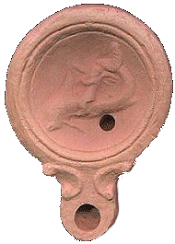 |
FISHBOURNE
Circa mid 1st Century AD.
The Fishbourne is molded
directly
from an original Roman lamp. It features a winged Cupid playing the
flute while riding a dolphin. This image was widespread throughout the
Roman world and is found in many forms
including sculpture, paintings, and mosaics. One such mosaic was found
in excavations of the Roman levels of the city of Fishbourne, England.
The original Roman lamp this
reproduction was cast from was acquired by the classical archaeologist
F.O. Waage, perhaps in the 1930's. (about
3.5" by 2.5")
|

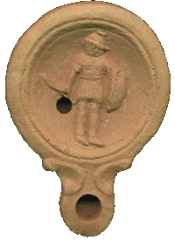 |
GLADIATOR
Circa mid 1st Century AD.
The same lamp body as the
Fishbourne, the discus features a standing Roman gladiator, a popular
theme on clay lamps.
(about 3.5" by 2.5")
|

 |
THRAEX
Circa mid 1st Century AD.
The same lamp body as the
Fishbourne, the discus features a standing Roman gladiator dressed in
the manner of the Thraex, or Thracian gladiator.
(about 3.5" by 2.5")
|

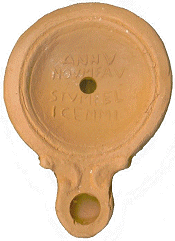 |
ANNVS NOVUS
Circa mid 1st Century AD
The
Latin inscription on this clay lamp is seen on a Roman lamp in the
British Museum. The translation is about the
equivalent of our own "Happy New Year". The words are abbreviated and
broken up just as they are on the original (Romans weren't
concerned with punctuation). Giving clay lamps to friends and family
was a
Roman tradition for the New Year. The body used for this lamp is cast
from the original Fishbourne body.
(about 3.5 by 2.5")
|

 |
CUNETIO
Circa mid 1st to early 2nd Century AD
Cunetio
was a Roman settlement in England. The design on this lamp
was a common motif on Roman lamps, depicting bathing Aphrodite,
called the Venus Accroopie. She holds in her hand a large sea
shell (a symbol of Venus) and has
a towel knotted about her head. The body used for this
replica lamp is taken from a cast of an original Roman lamp dating to
about AD 50.
(about 3.75 by 2.5")
|

 |
VINTIUM
Circa mid 1st Century AD
Grapes
were a popular decoration on Roman lamps, just as wine was popular at
Roman banquets. The Vintium, named for a Roman colony in France, has a
grape bunch on the discus of the original Fishbourne body.
(3.5" by 2.5")
|

 |
TRIDENT
Circa mid 1st to early 2nd Century AD
This lamp has a dolphin carrying a
trident. Many examples of this motif are known from Roman lamps, and is
probably related to Neptune. The
body for this lamp was cast from an original Roman
lamp in England, and the design carved into the gypsum mold
using originals as models.
(about 3.75" by 2.5")
|

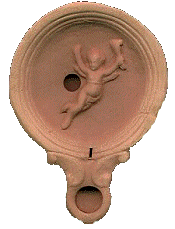 |
EROS
Circa
mid 1st Century AD
Eros, or Cupid,
appears with great frequency on Roman and Greek lamps. This winged Eros
holds a torch. The body for this lamp was made using
the original "Fishbourne" lamp above.
(about 3.75" by 2.5")
|

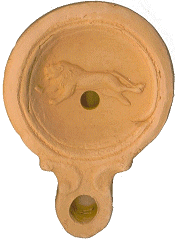 |
CIRCESIUM
Circa mid 1st Century AD
Romans
loved the excitement of the games, as well as exotic animals. This lamp
has a running lion on the discus, a favourite wild beast in Roman art.
Circesium was a Roman settlement in Syria, plus we get our word for
circus from these Roman games. The body for this lamp uses the original
at the top of the page.
(about 3.5" by 2.5")
|

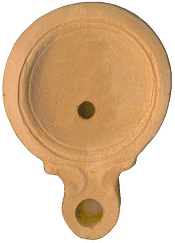 |
SALARIA
Circa
mid 1st to early 2nd Century AD
A plain utility
lamp of the mid 1st Century AD using the body of the original Fishbourne lamp, but having no other decoration.
(about 3.5" by 2.5")
|

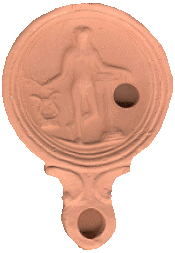 |
APOLLONIA
Circa mid 1st Century AD
To the Greeks and Romans, among other things Apollo oversaw the arts,
learning, and healing. Here he with a laurel branch in his hand, and a
lyre by his feet, symbols of his place in education and music.
(about 3.5" by 2.5")
|

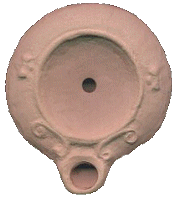 |
KNOSSOS
Circa late 1st to late 2nd Century AD
Knossos
was a city on Crete. Among the many symbols found there is the
double axe, which looks somewhat similar to the time-worn
elements on
this lamp. This replica was molded directly from an original Roman
lamp.
(about 2.75" in diameter)
|

 |
NOVUM
VINTUM
Circa 1st to 3rd
Century AD
A
lamp body typical of the late 1st through late 2nd Century AD, and also
into the 3rd century. The central discus features a grape bunch, and
the
shoulders have repeating arc.
(about 3" in
diameter)
|

 |
TIVOLI
Circa 1st to 3rd
Century AD
This
style of clay lamp was common from about AD 25 to AD 150, but could be
found well into the 3rd century. The earlier versions, however, tended
to lack handles as the lamps on the Roman Empire
page have.
(diameter 3.5")
|

 The information and graphics on
this site are
protected by copyright law. The information and graphics on
this site are
protected by copyright law.
|


















